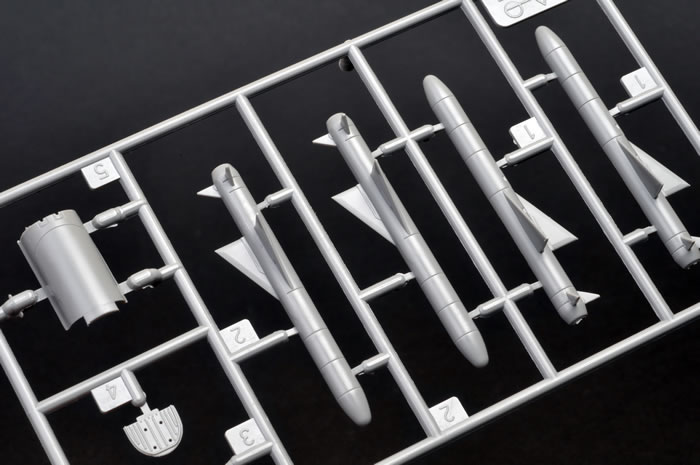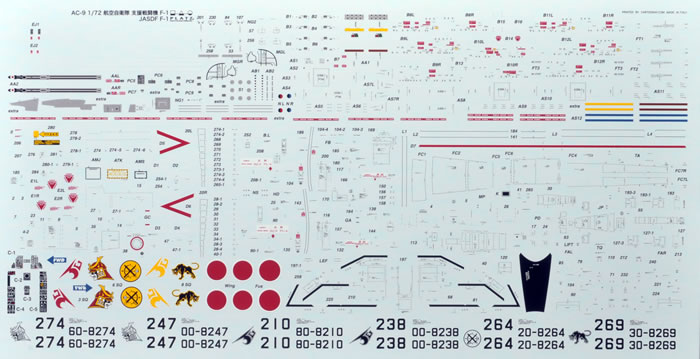|
Mitsubishi F-1

Platz, 1/72 scale
S u m m a r y : |
Catalogue Number: |
Platz Kit No. AC-9 - Mitsubishi F-1 |
Scale: |
1/72 |
Contents & Media |
120 grey (10 being surplus) and 9 clear styrene parts, with decals s for 6 different aircraft with the same colour scheme. |
Price: |
Available online from these stockists: |
Platz Models |
Hobby Link Japan |
Aviation Megastore |
¥2,520 |
¥1,920 |
€18.14 |
Review Type: |
First Look. |
Advantages: |
Very good quality moulding, nice surface detail, excellently printed decals, very good instructions, and good value. |
Disadvantages: |
None apparent. |
Conclusions: |
This is a very nicely engineered kit produced to high standards, reminiscent of the latest Hasegawa kits, although the parts breakdown still manages to seem straightforward and simple without an enormous parts count. External detail is nicely done throughout, with some very nice touches in places, whilst cockpit detail is adequate. The instructions plus painting and markings guide is also very clear and laid out well. The decals are simply superb, with a tour de force where stencilling is concerned.
This looks to be an excellent kit, and is definitely a step up compared to the only alternative from Hasegawa (and extremely well priced in comparison). I thoroughly recommend it. |
Reviewed by Mark Davies

Valom's 1/48 scale An-2 Colt is available online from Squadron.com
The Mitsubishi F-1 is Japan's first post-World War II domestically developed and built jet fighter to enter production in Japan since the end of World War II, thus it was nicknamed "Supersonic Rei-Sen". Mitsubishi Heavy Industries and Fuji Heavy Industries jointly developed the F-1. At first glance, it resembles the French/Anglo SEPECAT Jaguar, but was a completely independent Japanese effort (although it uses the same engines).
In the mid 1960s, the Japan Air Self-Defense Force (JASDF) commenced studies into an advanced jet trainer which could also be modified to serve in the ground attack and anti-shipping roles. After considering license production of the T-38 Talon and SEPECAT Jaguar, Japan decided to develop its own trainer, the supersonic Mitsubishi T-2, this first flying on 20 July 1971. Cost over-runs in the T-2 program lead to the proposed single seat attack version almost being abandoned, but the cancellation of the Kawasaki P-XL, the planned replacement for Japan's Kawasaki P-2J maritime patrol aircraft freed-up funds, while making it important to keep Japan's aviation industry employed, and contracts were awarded for the development of the attack version as the FS-T2kai in 1973.
The new aircraft was a minimum change derivative of the T-2, with the rear cockpit being converted to an avionics bay by removing the rear seat, and replacing the canopy with a simple unglazed access hatch. Two additional hard-points were fitted under the wing to allow carriage of a heavier weapon load, and the avionics were improved, with a new J/AWG-12 radar set, similar to that fitted in British Royal Air Force F-4M Phantom fighter jets. This set provides ranging information. Aside from the avionics changes, deletion of the rear seat, and new one-piece canopy, the only other major change from the T-2 was the strengthening of the airframe to enable it to carry a larger weapons load than the T-2. The F-1 is fitted with an internally mounted 20 mm JM61A1 Vulcan cannon with 750 rounds of ammunition. The aircraft also has seven external hard-points for the carriage of a wide variety of stores. The fuselage hard-point and inboard pair of underwing hard-points are "wet", which means they can be used to carry external fuel tanks to increase the aircraft's range. The primary weapon of the F-1 is the ASM-1 and the newer ASM-2 long-range anti-ship missile. This weapon is roughly in the class of the American AGM-84 Harpoon or French AM.39 Exocet. Other weapons carried include the all-aspect short-range heat-seeking AIM-9 Sidewinder air-to-air missile for air-to-air combat. This weapon is carried on the wingtip rails usually, but it can also be carried on the outboard underwing hard-points for the F-1's secondary air defense role. Other air-to-ground weapons carried include rocket pods (JLAU-3/A) of 70 mm (2.75 in) size as well as bombs of 227 kg (500 lb) and 340 kg (750 lb) in size (Mk82 and M117 respectively). In addition, the Mk-82 and M117 bombs can be fitted with infrared guidance kits, turning them into precision-guided weapons that home in on heat radiation emitted from seaborne targets such as ships or other ground-based targets. When fitted with this kit, the bomb becomes known as GCS-1.
The F-1 has slowly been replaced over the years by the newer F-2 (Japan/U.S. developed, based on F-16C/D), as well as upgraded F-4EJ "Kai" Phantom IIs. Units currently using the F-1 are scheduled to change over to the new F-2 over the next several years. One unit has already traded in its F-1s for F-4EJ Kais. The last six active F-1s, based at Tsuiki in Fukuoka Prefecture, were retired on 9 March 2006, having reached the 4,000 hour limit of their airframes.
Source: wikipedia.org
Previous 1/72 F-1 Kits
I am aware of only one previous F-1 in 1/72 scale by Hasegawa (not counting ready-made models by the likes of Hobby Master). This was a very good effort despite being one of their older kits that still featured raised panel line detail; albeit very fine. As with some other modern Japanese subjects kitted by Hasegawa I have owned, I had the impression that some extra effort had gone into the kit’s development. It has been released with several markings variations and boxings in typical Hasegawa fashion.
The kit comes in a typical Japanese top-opening box made from good quality glossy card. Written instructions are predominantly in Japanese, although there is sufficient use of English throughout to assist those more familiar with English or other European languages. The instructions are easy enough to follow with simple but clear diagrammatic assembly stages. The parts come enclosed in a plastic bag, with the clear parts and decals further protected in their own bags.
As with other Platz kits I have reviewed, I found crisply moulded parts with delicate engraved panel detail, and the decals appear to be extremely well printed.
The Airframe
Cockpit detail is reasonable for the scale with crisp raised detail on the instrument panels and consoles, although there are decals for these parts as well. A console located under the windscreen with clear HUD is also provided. The seat is an acceptable facsimile of the real thing, which is handy as I am unaware of a resin aftermarket replacement. It requires at least some additional harness straps to look good however. The clear canopy is also well done, consisting of two clear pieces and a grey plastic hinged frame. There is a choice of the original framed or later frameless windscreens fitted after 1989. Guidance as to which should be used with which markings option is easy to miss initially; however, this is provided in the colours and makings guide by where the windscreen part number (J1 or J3) is indicated for each option.

The twin cockpit tub and extra instrument panels clearly indicate that the T-2 trainer variant is also to be offered, as would only be logical given its similarity to the F-1.
The fuselage has two main halves that incorporate the main wheel-wells, a separate rear underside section and separate front wheel-well. The separate air intakes have a reasonable suggestion of internal ducting (and even include some internal engraved detail where auxiliary intake doors are); although too short, some matt-black shading should suggest sufficient depth. The wings have a single upper piece with thin trailing edges and control surfaces moulded in. This then has two underwing sections to insert and separate leading edges and inner wing root parts to attach. The horizontal and vertical stabilisers are all one-piece items. A separate panel for the Vulcan cannon fits into the port fuselage side, along with a small part that then fits to this panel to simulate the cannon’s blast-port. The engine exhausts are three-piece items and nicely done. Deployable airbrakes, an arrestor hook and a few additional details like small scoops round out the airframe, along with of course the undercarriage and its doors. The undercarriage is good and captures the chunky appearance of the original.
The kit’s appearance suggests that it will build extremely well. However, I have read one build review that mentions problems with fitting the cockpit tub, possibly attributable to the instrument panel and the need to trim it. Some windscreen fit problems were also experienced, again possibly related to the cockpit fit. I mention it here to advise readers to take extra caution in this area.
Payloads
The kit provides various hard-points and the following external stores, for which the instructions provide a table showing what can be carried and where:
-
3 x 220 gallon external tanks (on extra provided due to sprue duplication),
-
2 x AIM-9 Sidewinder,
-
2 x ASM-1 anti-shipping missile,
-
1 x CBLS-200 practice bomb dispenser,
-
4 x Practice bombs,
-
4 x Triple Ejector Racks, and
-
1 x Multiple Ejector Rack.

The missile rails are notable for their nice detail, and are better than many of the rather simplified examples found in some other kits.
Colours and Markings
The kit offers six markings options (with information on only five), these being:
-
60-8274,
-
00-8247, 3 SQ (Late),
-
80-8210, 3 SQ (Early),
-
00-8238, 8 SQ (Early),
-
20-8264, 6 SQ, and
-
30-8269, 8 SQ (Late)
The monochrome colours and markings guide is extremely thorough, covering two pages, with numerous small notes for detail painting. A further half-page covers weapons and hard-points. Colour call-outs relate to the Gunze Sangyo/Mr. Color and Testors/Modelmaster paint ranges. Also useful, is their provision of some FS-595 and even RLM codes as well.

The decals are by Cartograf and appear to be printed superbly, with a plethora of stencil markings. In fact, I can well imagine that decal application will prove to be the most time-consuming part of completing this kit. I like the inclusion of decals for the canopy frame sealant, and what look like remove before flight tags.
This is a very nicely engineered kit produced to high standards, reminiscent of the latest Hasegawa kits, although the parts breakdown still manages to seem straightforward and simple without an enormous parts count. External detail is nicely done throughout, with some very nice touches in places, whilst cockpit detail is adequate. The instructions plus painting and markings guide is also very clear and laid out well. The decals are simply superb, with a tour de force where stencilling is concerned.
This looks to be an excellent kit, and is definitely a step up compared to the only alternative from Hasegawa (and extremely well priced in comparison). I thoroughly recommend it.
Thanks to Platz for the review sample
Text and Images Copyright © 2014 by Mark Davies
Page Created 28 January, 2014
Last updated
28 January, 2014
Back to HyperScale Main Page
Back to Reviews Page

|
